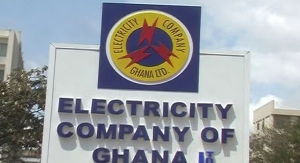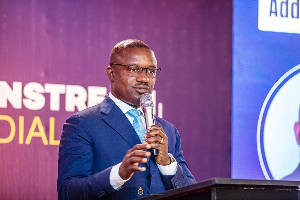There is no doubt that the vaunted STX project is beset with funding challenges.
It is also clear that the company that was awarded the project – STX Engineering & Construction Limited (STX E&C) – is on the verge of falling apart, if it hasn’t already. The evidence clearly shows a complete breakdown of trust amongst the directors of the company, with one faction having formally reported the other to the Police on suspicion of criminal conduct. Civil lawsuits by both parties are also pending.
It is depressing to witness the impression being created by certain supporters of the STX project that none of this was foreseen. The new catch-all phrase for this monumental mess is: “boardroom wrangling”. As to the exact cause of this “boardroom wrangling” no one appears able to give us clear answers.
Many concerns were raised about the STX deal. Some of those concerns clearly and presciently predicted all the key problems currently bedevilling the project.
Mr. B.K. Asamoah, the CEO of STX E&C cites as his main difficulties with the Koreans the following:
1. A lack of evidence that they can raise the necessary funds from Korean lenders and investors. By June of this year, STX Construction Korea was still putting together the prospectus for fund-raising. Woori Bank and the Korean Infra Fund, whose interest had been cited as evidence of STX Korea’s readiness to fund the project in Ghana, have apparently backed off.
2. A lack of commitment by the Korean partners to the use of local content in the project.
3. Disrespect for the Ghanaian management of the STX E&C entity.
STX Construction Korea, the majority equity partners in STX E&C, cite as their main difficulties with Mr. B.K. Asamoah and his G.K. Airports company (the minority equity partners in STX E&C) the following:
1. A lack of financial capacity to contribute to the capitalisation of STX E&C. GK Airports has not been able to raise its share of $5 million required to bolster the balance sheet of the company being presented to investors and creditors for investment consideration.
2. Suspicion of fraudulent conduct on the part of GK Airports in the use of certain documents purporting to tie the Koreans to certain commitments.
In the disclosed minutes of meetings held by an ad hoc Presidential Committee, there is evidence of massive disagreements over the roles and obligations of the members of STX E&C, that is to say: GK Airports and STX Construction Korea.
There are many more problems with STX than the publicly available information might suggest, but for now let us stick to these 5 competing concerns expressed by the partners.
Firstly, many critics of STX clearly mentioned the lack of ready financing for the project, but they were loudly shouted down. STX proponents said over and over again that the Korean government was behind the deal and therefore that financing was a straightforward matter. When some critics pointed to the complete lack of evidence for this belief they were met with snorts of derision.
Secondly, when issues of local content came up, wild promises were made concerning technology transfer and skills training of Ghanaian workers. The impression was created that this was guaranteed by the existing agreements and understandings. Clearly it was not; otherwise more than a year on the partners wouldn’t be quibbling over what is and what isn’t expected of them. This is not “boardroom wrangling” but utter confusion and a lack of any direction whatsoever about how the project should proceed: a clear sign of poor pre-closing planning.
Thirdly, any questions asked about the track record of GK Airports and its parent holding companies: GK Holdings and Delamore Group were brushed aside. Proper due diligence should have established that GK Holdings has no track record in large, complex, projects of this nature and were unlikely to provide a proper “Ghanaian” counterbalance to the Koreans.
Clearly, we were misled into believing that Ghana was adequately represented in this deal (in fact the project was called: a “Ghana – Korea joint venture”). From what has become evident, Ghana is not. The role of other Korean intermediaries, with dubious standing in the whole affair, besides the respected, if also heavily indebted, STX Construction Korea would also, in any proper due diligence, have triggered a bit more vigilance.
Fourthly, the disrespect of the Koreans for the Ghanaian counterparts stem directly from a feeling of resentment about the latter not pulling its weight. They simply don’t understand why they should do all the work and grant G.K. Airports 30% equity in the joint venture if G.K. Airports can’t even raise $1.5 million on its own credit.
It is completely inaccurate to suggest that critics of the STX deal, as railroaded through Parliament, did not point to a need for a thorough scrutiny of the joint venture and incorporation documents which set up STX E&C (see: *imanighana**.org/?q=node/141 and imanighana.org/?q=node/161). *They did but their questions were drowned by a choir of uncritical praise singers of the deal, some of whom even went as far as paint vivid portraits of an industrial renaissance in Ghana on the back of STX.
The admonishment about the need for extended due diligence on this overambitious undertaking was based on the very mechanics of the deal, and not just issues of value for money. Concerns about the deal’s financing (GK Airports’ main current source of disquiet) from Korea or elsewhere featured just as prominently in the points raised by STX critics. These acts of blatant neglect and lack of even rudimentary diligence cannot be attributed to standard project risks.
We see the same lack of rigour in the current approach being taken by pro-STX campaigners in their bid to “save” the deal. This attitude needs urgent reform.
At the very core of the project are a number of fundamental flaws.
Firstly, a sovereign guarantee is usually most useful if a government is merely a third-party assuming the extra-financial risks of a private project developer seeking to raise funds from a creditor in a context where the private developer shall be primarily responsible for repayment. In this case however because the houses are meant to be freely distributed to security forces, or sold to them at very nominal prices, the private developer cannot logically be expected to bear the primary repayment obligation.
The houses are actually meant for the Government of Ghana, which to all intents and purposes is the primary borrower. The sovereign guarantee adds little more than cosmetic dressing, since the credit of the government of Ghana is already on the line, and spelt out in the supplier credit facility, and further reinforced by political risk insurance. The sovereign guarantee is therefore seeking to address both the credit risk and the project risk inherent in the project, which is somewhat unusual. In these circumstances, government of Ghana might as well just have gone out to borrow the money and afterwards contracted STXE&C or whoever to build the houses.
The use of a “supplier’s credit facility” creates the impression that STX E&C has superior credit compared to the government of Ghana. The sovereign guarantee suggests the opposite. Conceptually, the effect is one of confusion.
Secondly, it is ridiculous to venture onto the commercial markets in search of a concessional loan facility adorned with a grant element and a significant grace period to boot. International Banks are not in the business of charity concerts.
During the heat of the controversy over STX, many people made the point that it is silly to determine borrowing terms for a credit facility without a bank guarantee. It is like putting a cart before the horse. In response, STX proponents vigorously insisted on the support of pre-committed financial institutions and sources of credit in Korea.
It is frustrating to hear from these same people today that none of the elements in the current impasse was foreseen. It is in fact most remarkable to see how many of the predictions have actually manifested.
Having listened carefully to STX proponents since the underperformance of the contract became evident, we have decided to speak up again because the lack of rigorous debate has returned once more.
When pressed to identify possible sources of finance, the Minister in charge has variously mentioned Barclays Capital and Standard chartered (Stanchart).
Barclays Capital’s TOTAL funds under management in the infrastructure sector are roughly equivalent to the amount of funding being sought for the STX project, and are almost exclusively focussed on Europe. Given comparative rates of return in other sectors and other emerging markets one struggles to understand why Barclays Capital will want to get involved in the building of barracks on concessional terms.
The infrastructure segment of Stanchart’s principal finance business, on the other hand, is firmly focussed on Asia.
In some of the meetings with the Presidential Committee set up to resolve the difficulties with this project, Mr. B.K. Asamoah is reported to have claimed that he and his partners have raised funding amounting to billions of dollars. When pressed, he is said to have mentioned the source as: “US treasury bonds”. Without prejudicing his efforts, or denigrating whoever his new financial partners might be, one is nonetheless inclined to be sceptical seeing that “treasury bond” financing is a very well known variant of international finance scams.
Another focus that has emerged in recent times is the use of “aluminium forms” technology, a method involving the use of aluminium shells and frames to hold concrete and thereby provide structure and functional elements to buildings.
This technology has been not suitably tested. The Korean partners completely object to its use, preferring conventional building methods (a point that of course begs the question of “technology transfer”, another loose justification sued to railroad the deal through).
The company behind Western Forms is a medium-sized family-owned business in Kansas with no experience delivering on a project this massive. In fact, it increasingly outsources the manufacturing of the aforementioned building material to other companies. It also makes less than $20 million in revenue annually.
Only small projects have to date relied on this technology. An Indian investor developing affordable housing in India is the only one to have placed significant hope in their use for mass housing projects in the tropics. To date he has sold roughly 1000 of them (at between $11,000 and $22,000) but has only built a couple of demonstration models. The company championing the effort in India - VBHC- mentions considerable requirements for mechanisation to achieve a 25% saving on time, compared to conventional construction.
To set up a project of STX’s size in Ghana using aluminium forms will require substantial planning and execution. The requirements for specialised equipment and consultants alone would severely strain the project financing capacity of Western Forms, even supposing they can be charmed to get involved at that level, not to talk of a construction of 6000 houses a year in tropical Africa.
Equally relevant is the fact that the use of aluminium conduits for concrete has a somewhat chequered history in construction. Both the US Army Corps of Engineers and the Washington DC Building Department have since the mid-1960s advised strong caution against the use of such conduits. Western Forms may have improved the technology as part of its intellectual property development, but one wonders whether a project of this scale can rely on what is still a relatively novel technique. Of course, while STX Construction Korea remains in the picture, there is no chance of this technology being adopted.
At any rate, the frequent changes in the specifications of the project, with technology matters still under consideration renders untenable the claims by STX proponents that funding has been secured. Why would a bank release funding for a project with incomplete engineering and technical specifications?
And then again, why should parliament be stampeded into approving a project very much still on the drawing board? Why should the President of the Republic be induced into launching the commencement of such a project with so much work still outstanding?
Let’s stop playing the ostrich about STX. The unseemly haste with which it was rushed through Parliament before it was ready and the taunting attitude of its promoters and supporters have contributed to the monumental mess it has become. The huge number of man hours spent on this poorly conceived project has a clear cost. The growing damage to Ghana’s reputation in international financial circles as the increasingly frayed sovereign guarantee instrument travels the oceans looking for takers has a clear cost.
Some well-meaning critics have advised the Government to return the STX agreement to parliament, while this may satisfy certain legislative requirements in the case where certain terms may need to be amended, the facts are that: government has precious few new ideas to present as far as this particular agreement is concerned and the political costs of returning to parliament without any clear view about how to make an essentially unworkable agreement feasible may prove too much. Until a genuine departure from the mess in the original agreement is in sight, returning the flawed document to Parliament will achieve little.
Government of Ghana needs to wake up to the reality and step up to propose some creative solutions to salvage the situation. Given the absence of such bold ideas in recent discussions, we are compelled to humbly suggest a few for consideration.
Firstly, no one disputes the reality of a housing crisis in Ghana. Secondly, no one is blind to the fact that raising capital to fund socially improving projects in an African country like ours is a very tough undertaking and therefore that government should look for innovative partnerships to advance the development process. Thirdly, no one objects to the embrasure of major global corporations by Government of Ghana to boost local capacity where such capacity needs to be boosted.
What everybody objects to is shoddy project design, lack of due diligence, and disdain for constructive, reflective, advice or criticism.
With these clarifications in mind, we can go ahead and ask government of Ghana to consider maintaining its relationship with the three main parties that have expressed strong interest in partnering with it to solve the housing crisis: GREDA, STX Construction Korea and GK Airports, while at the same time keeping the doors opened for any new companies that show sufficient interest and wherewithal.
It is now clear what the strengths and limitations of each of these entities are. Government should vindicate these perceptions about their capacity by setting clear preliminary some may even say probationary tests for each of these parties to meet.
To do this, Government may consider first of all setting up a limited liability company (for now, let’s call it: “Ghana Housing Investment Company” – “GHICO”) and vesting it with title in all the land earmarked for the so-called “Ghana National Housing Project” (a phrase, incidentally, said to be protected by copyright for the benefit of Mr. B.K. Asamoah). This should capitalise the company substantially.
Government may then enter different agreements with these companies, as well as any others that come in, based on the experience government has acquired over the past two years pursuing this Ghana National Housing Project idea. The size of each separate project must be commensurate with the demonstrated strengths and track record of each “partner”. Needless to say due diligence and feasibility planning would have to be thorough in every instance.
The GHICO entity would be able to raise some initial capital to give some foundation to each venture, while at the same time representing the national interest in the overall set of projects. It could make land available to its different partners in accordance with a thoroughly scrutinised specifications blueprint. It shall, as already mentioned, be able to raise capital using some of its land holdings as collateral. Unlike the State Housing Corporation, however, its main focus shall be investment advisory not construction.
A multi-partner arrangement shall also be useful in addressing another flaw in the STX blueprint: the prioritisation of concessional housing rather than affordable housing. If the initial focus had been on affordable houses within the $10,000 to $20,000 range, to be built and sold to lower middle income professionals like teachers, nurses, technicians, etc. the project’s financial model would have been much more robust and the story could be different today.
In a multi-partner arrangement, government can pursue both concessional (to be distributed gratis or near-gratis to the security forces) and affordable housing (to be sold via mortgage financing to lower middle income groups), using the appropriate financial structuring to diversify project risks, rather than the mishmash we have in the current STX deal.
Having thus, through the GHICO framework, blessed the divorce of the unworkable marriage that is STX E&C, placated both partners for their efforts and expenses to date, and salvaged some of the mess in the original plan, government can then proceed to RESCIND the STX agreement with the mutual agreement of all involved.
We can from there begin talking about returning the Government's Affordable Housing Policy to Government, whenever the threshold for such parliamentary ratification is reached.
A sorry chapter in our development story can then be closed, and no one need shed any tears.
*Credit: IMANI-Ghana (syndicated via www.AfricanLiberty.org
Opinions of Tuesday, 30 August 2011
Columnist: IMANI






![The suspect, Daniel Tuffuor [L] and deceased Yobani Deladem Aku The suspect, Daniel Tuffuor [L] and deceased Yobani Deladem Aku](https://cdn.ghanaweb.com/imagelib/pics/404/40485450.295.jpg)











